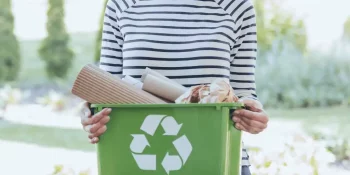Flood Emergency Preparedness and Resident Communications
Coastal communities aren't the only ones that need to prepare for a flood disaster.
hey can be caused by heavy rain, storm surge, a tropical cyclone, hurricanes, tsunamis, and even high tides. Floods and flash floods are terrifying natural disasters because they are a consequence of so many other types of weather events. Every state in the United States has areas that are at risk of flooding, and each year, these deadly and devastating disasters claim hundreds of lives. In 2016 alone, 126 Americans lost their lives due to flooding or flash flooding, and nearly 5 percent of those fatalities involved children under ten years of age.
Help keep your residents aware of the risks associated with flooding year-round with regular reminders regarding flood safety and preparation best practices. If a flood event occurs in your community, follow our emergency communication best practices below to keep residents and travelers informed before, during, and after a flood event occurs.
The Risks of Flooding Coast to Coast
According to FloodSafety.com, in the United States, flash flooding is the leading cause of weather-related deaths, and over 50 percent of flood-related drownings involve motor vehicles. While any state could experience a flooding event, the states that face the greatest risk include:
- Florida
- Louisiana
- California
- New Jersey
- New York
- Virginia
- South Carolina
- North Carolina
- Massachusetts
- Georgia
If your community is in any of these states, or if your community is in a known risk area for heavy rains, hurricanes, tsunamis, or other flood-related natural disasters, share the following flood safety tips with your residents on a regular basis. Keeping flood safety tips top of mind will help to ensure residents are prepared to act safely if a flood event occurs.
Before a Flood
If a flood event is predicted:
- Determine if your home is in a flood zone and understand your area’s flood evacuation route options
- Keep an emergency kit stocked and in your home. Your safety kit should include a flashlight, batteries, bottled water, canned food, a weather radio, and first aid supplies
- Keep important contact information in an easily accessible location, such as the phone number for your local fire department and your utility companies
- Ensure you have at least an extra three days of any prescribed medications on hand
- Create a family communications plan that outlines how you will be able to reach loved ones if a flood event occurs. Choose a dedicated evacuation location as well
- If time allows, prepare your home by lining the base of your exterior walls with sandbags
- Ensure your utilities are in proper working order, including plumbing check-valves and your sump pump; make sure electric circuit breakers or fuses are properly labeled and easily accessible
- Contact your insurance company to determine if your homeowners’ insurance policy includes flood insurance if you don’t have a separate flood policy
- Pack a bag for each family member in case you are instructed to evacuate
- Charge all your necessary electronic devices, including your cell phone, in case your power is lost during the storm or you are instructed to evacuate
- Sign up for emergency notifications from your local government
- If you are ordered to evacuate, do so promptly and by following designated evacuation routes; if time allows, disconnect appliances and utilities, and lock your home.
During a Flood
If a flood occurs and you were not able to evacuate, follow these safety recommendations:
- Avoid floodwaters; deep waters could mask dangerous debris or hazards, and unexpectedly fast currents could quickly carry you or your vehicle into an even more dangerous situation
- Get to higher ground
- Do not enter any room of your home where flood waters are covering electrical outlets or where electrical cords are submerged; if you see sparks or hear a buzzing, the water could be electrically charged; avoid the area at all costs
- Continually check for updates from your local government
After a Flood
After a flood event occurs, repairing damage to your home may take time. Follow these safety best practices in the days and weeks following a flood:
- Continue to avoid standing water
- If your local government announces a boil water advisory, follow all provided safety instructions until the boil water ban has been lifted
- If you are using a generator, carefully follow safety instructions, and do not use the generator in your home; carbon monoxide poisoning is a risk for the days post-flooding when generators are being used or when there has been damage to utility lines
- Stay out of disaster areas and allow safety experts to manage the recovery efforts
- Follow all road closure signage
- Continually check for updates about the recovery efforts from your local government; do not return to your home until authorities have advised it is safe to do so
Local Government Emergency Communication Best Practices
If severe flooding is projected to impact your community, follow these emergency preparedness communication best practices:
Communicate Early and Often
For news, updates, alerts, and instructions during a natural disaster, residents will turn first to their local government leaders. Keep citizens informed from the start of the event all the way through the recovery efforts. Share relevant and actionable information such as links to evacuation routes and emergency shelters, safety tips, and the latest news and updates on the recovery efforts.
Maintain a Calm Tone in All Communications
Your residents will feel more confident that their community is being protected and that their safety is being maintained if all your communications utilize a calm, confident, and informative tone. Make sure all news, updates, and information that you distribute have been verified and validated. During an emergency event, when a variety of credible and informal sources are all sharing information rapidly, the distribution of inaccurate information may complicate safety efforts.
Use All Available Channels to Distribute Safety Information, News, and Updates
This should include social media, your government website, text messages, phone, and email alerts. A mass notification system can help expedite multi-channel communications.
Tap into the IPAWS network
Created by FEMA, the Integrated Public Alert and Warning System (IPAWS) leverages national emergency communication channels such as emergency alert systems (EAS), wireless emergency alerts, NOAA weather radios, public TVS, and signage to provide area-specific alerts in times of emergency. It enables you to reach as many people as possible, including those who have not previously opted into emergency notifications, including visitors and nearby travelers.
By communicating preparedness and safety information to citizens regularly, the number of annual flood-related casualties can be reduced. Click below for more information on how an emergency mass notification system with IPAWS can help you reach as many residents as possible with emergency news and safety instructions.


